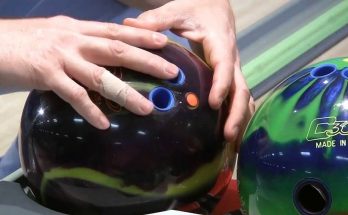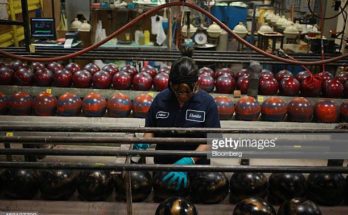The Torrent is Storm’s latest entry into their popular and affordable Thunder line. This ball uses the R2S Solid cover that has been around for years and combines it with a weight block that will look familiar to owners of balls from the Rocket series. While it may visually look similar to the Rocket cores, the Torrent uses a modified version called Booster HV. This core shape offers a higher RG and lower differential than the Booster core from the Rockets. The R2S Solid coverstock has been used previously on balls back to the solid versions of the Road balls in the Thunder line. On the Torrent, it comes out of the box at a sanded 2000 Abralon finish.
The Torrent’s rough cover had enough traction to give us our best reaction on our heavy oil test pattern. It was smoother off the end of the pattern, allowing all three testers to play straighter up the lane on the fresh. We had less total hook and less downlane motion than we had with other sanded Storm balls, such as the Alpha Crux and Phaze II. This allowed us to play more direct to the pocket on the fresh. All three testers liked the difference in motion the Torrent created compared with the other dull balls in the Storm line. We could stay with this ball longer on this pattern since it didn’t want to jump when it saw friction. As we started to break down the track area, we could start inching left with our feet to get the ball to store a little more energy to get it to hit.
Its slow response to the dry is why the Torrent was so good on our sport pattern. The 2000 Abralon finish was dull enough to grab strong in the midlane, but without burning up too quickly and losing pin carry. Like we saw on our heavy pattern, playing straighter through the front of the lane was the best strategy for all three testers. With less of a buildup of oil in the middle than our heavy pattern, we did have more success on the burn when we needed to get deeper with our feet and open up the lane. The lower volume allowed the Torrent to pick up a little earlier than on the heavy, eliminating the flat hit we sometimes saw on that pattern.
Our medium pattern was next, and Stroker and Tweener had the best reactions. They were both able to keep the Torrent at the box finish, using its strong midlane reaction to give them the best reaction to the pocket. They were both using a laydown point of around 15 and getting their balls out to around 10 at the breakpoint, with Stroker crossing just right of Tweener at the arrows. Cranker was forced farther left with his feet in order to catch enough oil in the front to get the box-finished Torrent down the lane. With that much angle, his ball lost too much energy for him to consistently kick out the corner. He used a 1000 Abralon pad followed by Storm Step 2 Compound on his ball to change its surface to a 1500 grit polished finish. The added length of this surface allowed his Torrent to retain its energy better and provide a greatly improved reaction on this pattern.
Strengths
The Torrent blended out all of our test patterns. Its smooth, predictable motion from its sanded solid cover provided plenty of traction through the oil across all of our patterns.
Weaknesses
The Torrent’s dull box finish requires that it sees some oil in the front of the lane to keep it from burning up at the pins. We saw flat hits when the track started to burn up and we couldn’t get the Torrent to get around the corner as strong as we needed with its sanded finish.
Overall Summary
The Torrent uses a new modified weight block with a classic coverstock. It was best for us on the fresh, where we could take advantage of its strong hooking motion. We saw similar motion to the Victory Road Solid of years past, and bowlers looking to replace their aging Victory Road Solid or Hy-Road Solid should definitely take a look at the Torrent.



